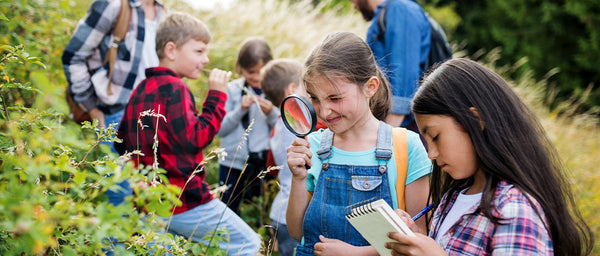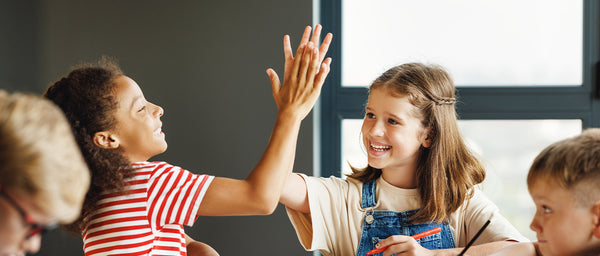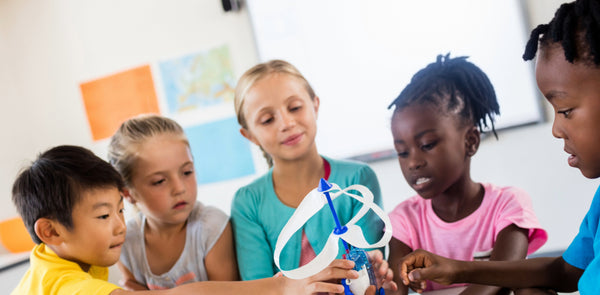
How to Create a Safe, Secure and Successful Makerspace
The Makerspace Lab
Can you think back to the first time you entered a laboratory? The beakers, the smells, the lab coats — it was a safe place for you and your fellow learners to experiment and design together. Whether your experience started with an after-school program, an elementary school field trip or a high school chemistry class, one thing was for certain the moment you entered the lab — safety was the biggest priority.
From strict rules about the type of footwear allowed to the eye and ear protection, the lab hinged on controlled, calculated measures of safety. After donning your personal protective equipment, you suddenly had the freedom to work with volatile chemicals or explosive agents. You were safe to experiment, learn and grow. Now, safety and protective equipment are never something to take for granted, accidents are a byproduct of complacency, but with the knowledge that a level of protection does exist, you're able to accelerate your students' speed of discovery.
It’s this same protective feeling that your makerspace needs to mirror.
Let's think about why. All over the nation, schools pack labs full of combustible materials and dangerous elements, and every hour, they sprinkle in a new batch of the world’s most explosive component — teenagers. It’s a recipe for disaster. Yet, day-in and day-out, the labs manage to avoid incidents. While it might seem like a miracle, it’s actually an achievement the instructor scaffolded the first day of lab, and it's a framework that they continue to build upon each day. So, how'd they do it?
They shifted their student’s perceptions of the environment.
The Paradigm Shift
In order to facilitate the change from horseplay to controlled chaos, every semester, science instructors have the "this lab is not a playground” conversation with their students. And from day one, the learners face the realities of what could go wrong in a lab if procedures are not followed to a T. From burns and cuts to maimings and blindness, it’s crucial that students understand the rules of the lab. And most importantly, that they understand the rules are there to protect them, not hinder them or their learning.
 In your makerspace, your students need to have the same level of understanding. While they are surrounded by their peers, learning, building and investigating, the makerspace is a different environment than their typical classroom, and it needs to be treated as such. Now, it’s a fine line to walk. On one hand, safety is a priority, but on the other, you don’t want to discourage and scare students away from ever investigating outside of their comfort zone. Through your procedures and precautions, you want safety to become second nature. When this happens, not only is it no longer seen as a burden, but safety is seen as a tool. When students know they are properly protected, there’s nothing stopping them from experimenting and investigating the odds and ends of your makerspace.
In your makerspace, your students need to have the same level of understanding. While they are surrounded by their peers, learning, building and investigating, the makerspace is a different environment than their typical classroom, and it needs to be treated as such. Now, it’s a fine line to walk. On one hand, safety is a priority, but on the other, you don’t want to discourage and scare students away from ever investigating outside of their comfort zone. Through your procedures and precautions, you want safety to become second nature. When this happens, not only is it no longer seen as a burden, but safety is seen as a tool. When students know they are properly protected, there’s nothing stopping them from experimenting and investigating the odds and ends of your makerspace.
Freshman Orientation
While both classrooms and makerspaces need to be warm and welcoming places to learn, places where students feel safe to collaborate, cooperate and share their ideas, the makerspace requires a certain level of participant professionalism.
Now, I can guess what you’re thinking.
"This all sounds great, but I know students, and I know their allergies to rules. How can you be so sure that they’ll listen to and actually follow the procedures of the makerspace?"
Well, it’s actually quite simple. Start by giving them responsibilities.
These responsibilities should begin their first day in the makerspace with a Rules and Safety Orientation. Whether you’re building a makerspace for the first time or you’ve been running one for years, every new student needs a full walk-through of your space and the procedures inside of it. Now, the orientation will vary depending on the unique aspects of your makerspace, but at the bare minimum, it needs to achieve two main things.
-
Showcase Your Space
This is your chance to give a full tour of the facility to new students and potentially their parents. Not only does this highlight what creative tools you have to offer, but for parents that happen to be along for the ride, it gives them an idea of what their student can achieve and the capabilities of your makerspace. This is an incredibly valuable word-of-mouth asset. The parents will talk to their friends, so show them what you've got! At the very least, you’ll be getting the new learner stoked to start creating.
-
Safety, Rules and Responsibilities
This is the most important part of your orientation. It’s where you lay out the rules of your space, highlighting safety procedures and the responsibilities that come with working in a makerspace. Not only should these rules and procedures be listed around your space, but this is a great time to introduce them to the new student in the form of a Creative Handbook.
Put together a packet that lists each rule, what to do in an emergency and the responsibilities of the makerspace, and send the information home, complete with a parent-signature-required form for them to bring back. Now, the makerspace rules don't stop here, they're a daily effort, but at least you are ensuring that they have the definitive ground rules available to them from day one — and, a signed document stating that they have read and understood the rules and safety procedures is a nice thing to have.
By implementing these two simple procedures into your orientation, not only are new creators met with the unlimited potential of your space, but they are also greeted by an environment that values their safety over everything else. And, with the signing the safety acknowledgment, you’re immediately giving the student some responsibility. Now, safety is no longer a chore or a hindrance, it’s their job. By entering your makerspace, they have the responsibility to keep themselves and others safe, to respect the equipment and to adhere to all rules and procedures. Using the space is a privilege, and it’s the student’s responsibility to keep that privilege by following your rules.
The Periodic Table of Safety
In the day-to-day life of your makerspace, the safety practices and procedures will be tested. As your learners innovate, collaborate and design, issues will arise and problems will pop up that you never imagined. While you can’t prepare for these, you can help prevent them from occurring these easy steps.
Signage: Along with labels designating where materials belong inside the makerspace, you need a clear and concise way to mark where safety equipment lives, what personal protective equipment is required to operate each tool and what to do in an emergency situation.

Simple graphics and signs in prominently displayed areas ensure that things like eye and sharp object protection are understood and adhered to without consistent supervision. These signs should serve as a constant reminder to students that in order to create in the makerspace, they must first be safe.
Cleaning: One of the biggest hazards your makerspace will have to prepare for is messiness. As their brains whirl around at 100mph, the last thing on a student’s mind will be to clean up after themselves. From half-finished projects laying in the middle of the floor to trash and cardboard building up around machines that generate heat, your makerspace needs to have strict cleaning procedures. Not only is it a sign of respect for the space, but it limits potential emergencies. In your environment, enforce a clean-up policy, as well as a tidy workstation mandate.
Certification:
One of the greatest things about makerspaces is that they allow the minds of our future to access the most cutting-edge technologies. These tools are incredibly valuable for learning, but some are also dangerous. While you want to allow your students access to these materials, you also need to weigh the cost of accessibility. One way to achieve this is through a certification process. From watching a video and completing a safety worksheet to practicing with supervision, gaining access to the biggest, most dangerous and expensive machines needs to be a multi-process step.

Every makerspace is as varied as the students who spend countless hours creating within them, and they all need to be safe. Take a page out of your high school chemistry teacher’s book, and treat your space like a lab. From a paradigm shift during orientation to continued learning with certifications, daily reminders, safety briefings and seminars, it’s your job to ensure your makerspace is safe. Luckily, it’s not a solo mission — find ways to share some of the responsibility with your students. After all, only they know what they are capable of!
If you’re looking to start your rule book or to refine a current version, check out
The Top 10 Makerspace Rules!
References:
Black, J. (n.d.). Lab Techniques 101: Introducing Your Students to the Chemistry Lab. Retrieved May 03, 2017, from http://www.carolina.com/teacher-resources/Interactive/lab-techniques-101/tr28304.tr
Hlubinka, M. (2015, October 23). Safety in School Makerspaces | Make:. Retrieved May 03, 2017, from http://makezine.com/2013/09/02/safety-in-school-makerspaces/
Makerspace Rules. (2015, October 26). Retrieved May 03, 2017, from https://wiki.somakeit.org.uk/wiki/Makerspace_Rules
Ortizjessica. (2015, June 29). Week 7 What are the rules for your Makerspace? Retrieved May 03, 2017, from https://jessicaortizrobotics.wordpress.com/2015/06/29/week-7-what-are-the-rules-for-your-makerspace/
United Federation of Teachers. (n.d.). Lab safety rules for students. Retrieved May 03, 2017, from http://www.uft.org/chapters/lab-specialists/lab-safety-rules-for-students










